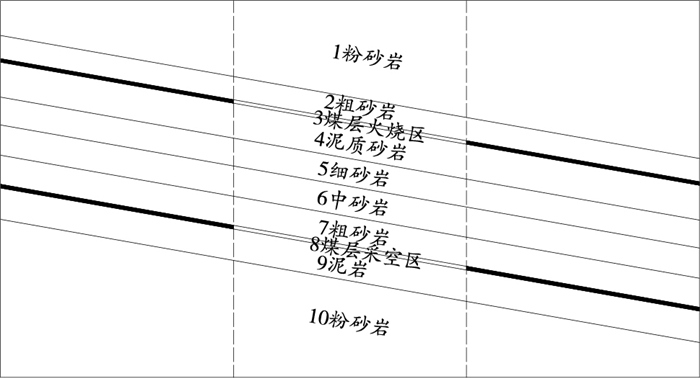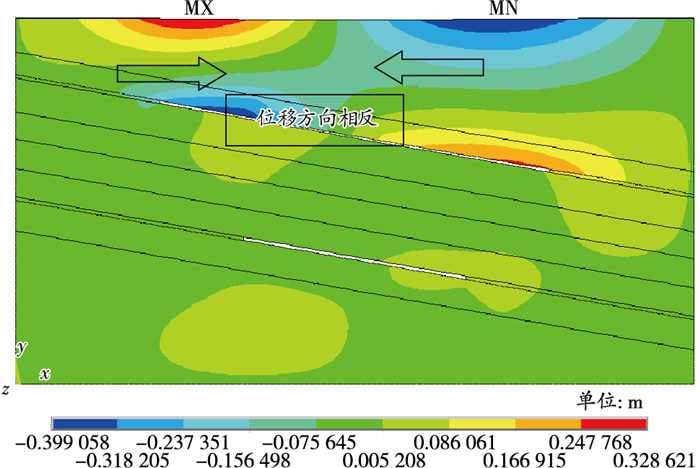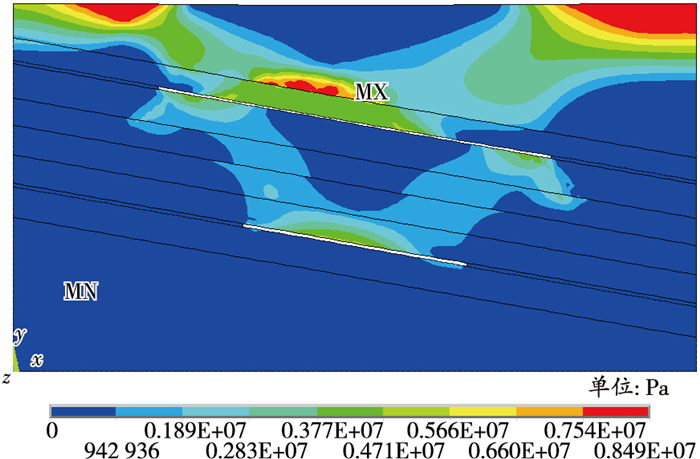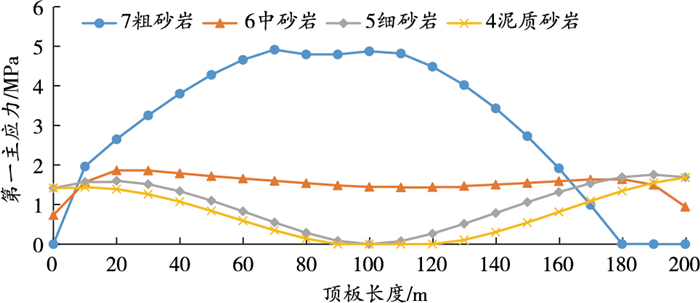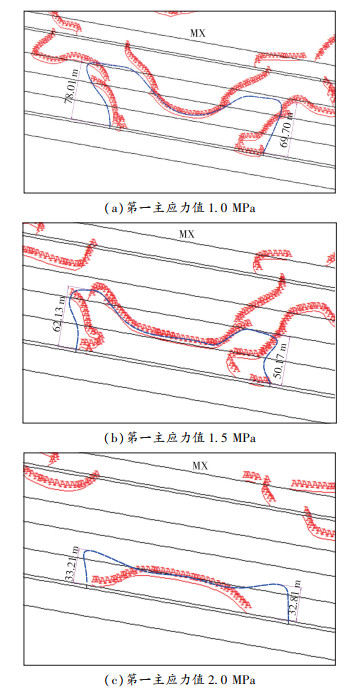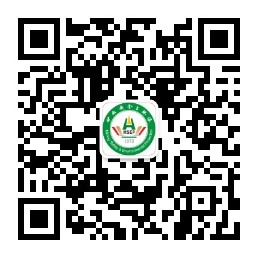Research on the development characteristics of water conducted zone in mining inclined coal seams with rich water in burning area
-
摘要:
为研究火烧区富水情况下煤层开采安全问题,需要准确分析开采覆岩导水裂隙带发育情况。运用有限元ANSYS模拟计算,基于第一强度理论,根据上覆岩层抗拉强度值,选择第一主应力值在1.5 MPa时的曲线范围作为导水裂隙带发育高度范围,并运用井下双端堵漏法进行观测验证,较为准确。研究得出导水裂隙发育强度准则可采用第一强度理论,第一主应力值在1.5 MPa时,导水裂隙带发育曲线范围在50.17~62.13 m,上边界未与火烧区沟通,下边界存在与上覆火烧区沟通现象,即火烧区积水是开采煤层的重大水患;同时在煤层倾斜情况下,导水裂隙带发育高度上边界要大于下边界,因此计算倾斜煤层导水裂隙带发育高度时,要考虑煤层倾角的影响。
Abstract:In order to study the safety issues of coal seam mining under the condition of abundant water in the burning area, it is necessary to accurately analyze the development of the water conducted zone in the mining overlying rock. By using finite element ANSYS simulation calculation and the first strength theory, based on the tensile strength value of the overlying rock layer, the curve range of the first principal stress value at 1.5 MPa was selected as the height range of the water conducted zone development, and verified with the observation of the underground double end sealing method, which is more accurate. It is concluded that the first strength theory can be used as the criterion for the development strength of water-conducting cracks. When the first principal stress value is 1.5 MPa, the development curve of the water conduced zone ranges from 50.17 m to 62.13 m. The upper boundary is not communicated with the burning area, while the lower boundary has communication with the overlying burning area. That is, water accumulation in the burning area is a major water hazard in coal seam mining. At the same time, in the case of inclined coal seams, the height of the development of water conducted zones should be greater at the upper boundary than at the lower boundary. Therefore, when calculating the development of water conducted zones in inclined coal seams, the influence of coal seam dip angle should be considered.
-
Keywords:
- burning area /
- water conducted zone /
- ANSYS simulation /
- first strength theory /
- coal seam dip angle
-
国内外相关学者对导水裂隙带的理论进行了长期研究。早在1968年,英国学者就开始按开采厚度来确定长壁式全面采煤法允许开采的最大煤层厚度 [ 1] 。我国的理论研究总体上已基本形成了各类条件下导水裂隙带高度(简称“导高”)预计公式,对影响导高发育的因素及导高发育的时间过程都有了较为明确的认识。郝庆旺等 [ 2] 提出了采动岩体孔隙扩散模型,以及考虑节理损伤的力学模型;王金庄 [ 3] 研究了连续大面积开采条件下托板控制岩层变形模型; 姜福兴等 [ 4] 提出了“岩层质量指数”;黄万朋等 [ 5] 提出了岩移“四带”模型,对解释和计算导水裂隙带的形状和高度具有较大的帮助;刘伟韬 [ 6] 、刘增辉 [ 7] 等采用FLAC数值模拟方法对导高的计算进行了研究。综上所述,我国对导水裂隙带的研究基本上采用经验统计 [ 8] 、类比 [ 9] 、数值模拟 [ 10- 11] (包括以ADINA、ANSYS、FLAC为主的有限元,以UDEC、MDEC等为主的离散元、边界元,以及离散元与边界元耦合等)、相似材料模拟、实测 [ 12- 14] (钻孔冲洗液法、钻孔电视法、瞬变电磁法、高密度电阻率法、超声波穿透法、声波CT层析成像技术、井下仰孔注水测漏法等),以及在某一类条件下的理论分析等 [ 15- 16] 。从总体上看,导水裂隙带研究主要侧重于上覆老空水、含水层下的煤层开采形成的采动裂隙,而针对上覆火烧区富水情况下的导水裂隙带研究较少,有必要对其进行深入研究。
1. 矿井概况
新疆榆树泉矿位于新疆库车县城北东15°方向的阿艾矿区榆树沟的中段,距库车县城的直线距离约55 km,南距阿格乡约25 km,东邻青岛大平滩勘查区。1013工作面位于捷斯德里克向斜西南翼,单斜构造,倾向北,倾角多为9°~13°,一般为10°左右。工作面上部存在火烧区积水,工作面顶板与烧变岩底板的层间距为103.50~120.57 m。为确保采煤安全,需开展导水裂隙带研究工作。
2. 数值模拟
2.1 计算模型
采用ANSYS模拟软件对火烧区下导水裂隙带进行模拟 [ 17- 19] 。模拟开采煤层采高3.2 m,上覆火烧区厚度3.0 m,平均采深153.0~263.8 m,工作面长度200 m,为了消除边界约束的影响,边界留200 m,计算模型几何尺寸沿走向( x)取600 m,深度方向( y)取324 m,足以模拟岩层移动变形情况。原岩应力为大地静应力场,各岩层为整合接触的连续介质。单元采用ANSYS的“PLANE82”弹塑性大变形等参平面结构单元。其地层力学计算参数见 表 1,ANSYS计算模型如 图 1所示。
表 1 力学计算参数Table 1. Mechanical calculation parameters块号 岩石类别 厚度/m 弹性模量/GPa 泊松比 密度/(t·m -3) 黏聚力/MPa 内摩擦角度/(°) 1 粉砂岩 30.0 3.8 0.25 2.63 6.0 35 2 粗砂岩 20.0 6.5 0.23 2.30 3.8 40 3 煤层 3.0 1.8 0.25 1.47 1.2 40 4 泥质砂岩 30.0 4.2 0.22 2.10 2.8 36 5 细砂岩 24.0 4.2 0.23 2.90 3.2 42 6 中砂岩 26.0 7.0 0.25 2.40 3.0 40 7 粗砂岩 25.0 6.5 0.23 2.30 3.8 40 8 煤 3.2 1.8 0.25 1.47 1.2 40 9 泥岩 27.0 2.3 0.32 2.89 1.3 33 10 粉砂岩 30.0 3.8 0.25 2.63 6.0 35 2.2 导水裂隙带计算分析
1) 位移变化情况
在地应力作用下,模拟计算煤层顶底板覆岩的 x、 y方向位移,结果如 图 2、 图 3所示。
由 图 2、 图 3可以看出,在地层作用下, x方向地表产生方向相反的位移,这与实际情况相吻合; y方向位移在煤层开采和火烧区范围内的位移最大,特别是重叠影响区位移最大,这也与实际情况相吻合,说明了模型计算的准确性。
2) 计算分析
导水裂隙发育强度准则可采用第一强度理论。该理论又称最大拉应力理论,认为破坏主因是最大拉应力,不论复杂还是简单的应力状态,只要第一主应力达到单向拉伸时的强度极限,即发生断裂 [ 20] 。
在地应力作用下,模拟计算煤层开采引起的覆岩变化第一主应力云图如 图 4所示。开采煤层至火烧区之间顶板岩石主要有泥质砂岩、细砂岩、中砂岩、粗砂岩,分别选取开采煤层顶板4层主要岩层,得到的第一主应力曲线如 图 5所示。
根据前期勘查资料,开采煤层顶板泥质砂岩、细砂岩、中砂岩、粗砂岩的抗拉强度分别为1.51、1.26、0.92、1.44 MPa。从 图 4可以看出,开采煤层顶板4层主要岩层所受应力均大于1.51 MPa,即顶板4层主要岩层均有裂隙产生。
为了研究煤层顶板覆岩导水裂隙带发育形态,以及与火烧区的导通关系,根据第一强度理论,选取第一主应力值,分别查看其分布情况,如 图 6所示。
从 图 6可以看出,第一主应力值在1.0 MPa时,导水裂隙带发育曲线范围在69.70~78.01 m,曲线发育整体较大,上边界和下边界均存在与上覆火烧区沟通现象;第一主应力值为1.5 MPa时,导水裂隙带发育曲线范围在50.17~62.13 m,上边界未与火烧区沟通,下边界存在与上覆火烧区沟通现象;第一主应力值为2.0 MPa时,导水裂隙带发育曲线范围在32.81~33.21 m,上、下边界均未与上覆火烧区沟通。根据上覆岩层抗拉强度值,选择第一主应力值为1.5 MPa时的曲线范围作为导水裂隙带发育高度范围。同时, 图 6中的3个分图均反映出,在煤层倾斜情况下,导水裂隙带发育高度上边界要大于下边界,因此计算倾斜煤层导水裂隙带发育高度时,要考虑煤层倾角的影响。
采用有限元ANSYS计算,勾画出在该矿地质条件下,在上覆砂岩层断裂情况下,煤层开采顶板覆岩导水裂隙带最大发育高度为50.17~62.13 m,其中开采煤层上方导水裂隙带发育高度大约为62.13 m,开采煤层下方导水裂隙带发育高度大约为50.17 m。
3. 井下双端堵漏法测试验证
采用双端堵漏法对火烧区下导水裂隙带进行观测 [ 21] ,观测结果如 图 7所示。
从 图 7钻孔深度方向上的漏失量可以看出,0~26 m为无漏失量阶段,主要原因为该段下伏煤层位于放水巷和运输巷之间的保护煤柱范围,属于实体煤,导水裂隙带未影响至该段;在27~44 m段,钻孔漏失量急剧增大,说明钻孔已经接近导水裂隙带马鞍形下边缘,随后漏失量相对稳定且较大,可能与该层段以粗砂岩为主,产生较多裂隙有关;在45~75 m段,漏失量变得不稳定,变化范围在3~4 L/min内,这可能与该层段粗砂岩与中砂岩互层有关;在76~87 m段,漏失量稳定在2.5~3.5 L/min;进入88 m后,漏失量急剧减小,说明钻孔可能已经接近导水裂隙带马鞍形上边缘,到90 m后降为0 L/min,说明到达马鞍形影响范围的上部。因此,依据实测分析,导水裂隙带高度测试基本能够确定为88 m×sin 35°≈50 m。这与数值模拟下边界结果50.17 m相当,说明模拟数据较为准确。
4. 结论
1) 基于ANSYS分析,导水裂隙发育强度准则可采用第一强度理论,只要第一主应力达到岩石单向拉伸时的强度极限,即认为岩层断裂,可较好地解决煤层开采引起的顶板导水裂隙带发育形态问题。
2) 通过采用有限元ANSYS计算,根据上覆岩层抗拉强度值,选择第一主应力值在1.5 MPa时的曲线范围作为导水裂隙带发育高度范围。导水裂隙带发育曲线范围在50.17~62.13 m,上边界未与火烧区沟通,下边界存在与上覆火烧区沟通现象,即火烧区积水是开采煤层重大水患。
3) 煤层倾斜情况下,导水裂隙带发育高度上边界要大于下边界,因此计算倾斜煤层导水裂隙带发育高度时,要考虑煤层倾角的影响。采用双端堵漏方法来观测倾斜煤层导水裂隙带时,应尽量选择开采煤层上边界进行观测。
-
表 1 力学计算参数
Table 1 Mechanical calculation parameters
块号 岩石类别 厚度/m 弹性模量/GPa 泊松比 密度/(t·m -3) 黏聚力/MPa 内摩擦角度/(°) 1 粉砂岩 30.0 3.8 0.25 2.63 6.0 35 2 粗砂岩 20.0 6.5 0.23 2.30 3.8 40 3 煤层 3.0 1.8 0.25 1.47 1.2 40 4 泥质砂岩 30.0 4.2 0.22 2.10 2.8 36 5 细砂岩 24.0 4.2 0.23 2.90 3.2 42 6 中砂岩 26.0 7.0 0.25 2.40 3.0 40 7 粗砂岩 25.0 6.5 0.23 2.30 3.8 40 8 煤 3.2 1.8 0.25 1.47 1.2 40 9 泥岩 27.0 2.3 0.32 2.89 1.3 33 10 粉砂岩 30.0 3.8 0.25 2.63 6.0 35 -
[1] 曹祖宝. 煤层顶板不同覆岩结构采动导水裂隙发育机理研究[D]. 北京: 煤炭科学研究总院, 2020. CAO Zubao. Development mechanism of mining-induced water flowing fractures in different overburden structure of coal seam[D]. Beijing: China Coal Research Institute, 2020.
[2] 郝庆旺, 马伟民. 非连续型下沉剖面方程与第二类广义概率积分法[J]. 中国矿业大学学报, 1991(2): 4-13. HAO Qingwang, MA Weimin. Discontinuous subsidence profile equations and the second type of generalized probability integration method[J]. Journal of China University of Mining & Technology, 1991(2): 4-13.
[3] 王金庄. 开采沉陷若干理论与技术问题研究[J]. 矿山测量, 2003(3): 1-5. WANG Jinzhuang. Research on some theories and technical problems regarding mining-induced subsidence[J]. Mine Surveying, 2003(3): 1-5.
[4] 姜福兴, 刘懿, 张益超, 等. 采场覆岩的"载荷三带" 结构模型及其在防冲领域的应用[J]. 岩石力学与工程学报, 2016, 35(12): 2398-2408. JIANG Fuxing, LIU Yi, ZHANG Yichao, et al. A three-zone structure loading model of overlying strata and its application on rockburst prevention[J]. Chinese Journal of Rock Mechanics and Engineering, 2016, 35(12): 2398-2408.
[5] 黄万朋, 高延法, 王波, 等. 覆岩组合结构下导水裂隙带演化规律与发育高度分析[J]. 采矿与安全工程学报, 2017, 34(2): 330-335. HUANG Wanpeng, GAO Yanfa, WANG Bo, et al. Evolution rule and development height of permeable fractured zone under combined-strata structure[J]. Journal of Mining & Safety Engineering, 2017, 34(2): 330-335.
[6] 刘伟韬, 陈志兴, 张茂鹏. 覆岩裂隙带发育高度数值模拟和现场实测[J]. 矿业安全与环保, 2016, 43(1): 57-60. LIU Weitao, CHEN Zhixing, ZHANG Maopeng. Numerical simulation and site measurement of development height of fractured zone in overburden strata[J]. Mining Safety & Environmental Protection, 2016, 43(1): 57-60.
[7] 刘增辉, 杨本水. 利用数值模拟方法确定导水裂隙带发育高度[J]. 矿业安全与环保, 2006, 33(5): 16-19. LIU Zenghui, YANG Benshui. Determining height of water-flowing fractured zone with numerical simulation method[J]. Mining Safety & Environmental Protection, 2006, 33(5): 16-19.
[8] 胡小娟, 李文平, 曹丁涛, 等. 综采导水裂隙带多因素影响指标研究与高度预计[J]. 煤炭学报, 2012, 37(4): 613-620. HU Xiaojuan, LI Wenping, CAO Dingtao, et al. Index of multiple factors and expected height of fully mechanized water flowing fractured zone[J]. Journal of China Coal Society, 2012, 37(4): 613-620.
[9] 马雄德, 王苏健, 蒋泽泉, 等. 神南矿区采煤导水裂隙带高度预测[J]. 西安科技大学学报, 2016, 43(1): 57-60. MA Xiongde, WANG Sujian, JIANG Zequan, et al. Height prediction of water conducting fracture zone in coal mining in Shennan mining area[J]. Journal of Xi'an University of Science and Technology, 2016, 43(1): 57-60.
[10] 梁世伟. 榆阳煤矿2301工作面导水裂隙带高度的数值模拟[J]. 中国安全生产科学技术, 2013, 9(3): 46-50. LIANG Shiwei. Numerical simulation on development height of crack water conducted zone in 2301 face of Yuyang coal mine[J]. Journal of Safety Science and Technology, 2013, 9(3): 46-50.
[11] 王婉洁, 高富强. 工作面覆岩采动裂隙演化规律物理及数值模拟研究[J]. 采矿与岩层控制工程学报, 2023, 5(2): 17-26. WANG Wanjie, GAO Fuqiang. Study of the evolution of mining-induced fractures with longwall face proceeds-insight from physical and numerical modeling[J]. Journal of Mining and Strata Control Engineering, 2023, 5(2): 17-26.
[12] 鞠金峰, 马祥, 赵富强, 等. 东胜煤田导水裂缝发育及其分区特征研究[J]. 煤炭科学技术, 2022, 50(2): 202-212. JU Jinfeng, MA Xiang, ZHAO Fuqiang, et al. Development and zoning characteristic of water-conducted fractures in Dongsheng Coalfield[J]. Coal Science and Technology, 2022, 50(2): 202-212.
[13] 杜君武, 董振波. 雅店煤矿4号煤层开采导水裂隙带高度研究[J]. 矿业安全与环保, 2018, 45(5): 78-82. http://www.kyaqyhb.com/article/id/653a4690-8130-4ba6-b9c1-3579a3570204 DU Junwu, DONG Zhenbo. Research on the height of water flowing fractured zone in No. 4 coal seam of Yadian coal mine[J]. Mining Safety & Environmental Protection, 2018, 45(5): 78-82. http://www.kyaqyhb.com/article/id/653a4690-8130-4ba6-b9c1-3579a3570204
[14] 赵子浩, 刘进晓, 王来河, 等. 近水平煤层覆岩导水裂隙带高度预计与实测[J]. 矿业安全与环保, 2017, 44(2): 66-69. http://www.kyaqyhb.com/article/id/ce789b80-8bca-4dae-b658-4d613fd4bb31 ZHAO Zihao, LIU Jinxiao, WANG Laihe, et al. Prediction and actual measurement of water flowing fractured zone height in overburden strata of flat seam[J]. Mining Safety & Environmental Protection, 2017, 44(2): 66-69. http://www.kyaqyhb.com/article/id/ce789b80-8bca-4dae-b658-4d613fd4bb31
[15] 杨达明, 郭文兵, 赵高博, 等. 厚松散层软弱覆岩下综放开采导水裂隙带发育高度[J]. 煤炭学报, 2019, 44(11): 3308-3316. YANG Daming, GUO Wenbing, ZHAO Gaobo, et al. Height of water-conducting zone in longwall top-coal caving mining under thick alluvium and soft overburden[J]. Journal of China Coal Society, 2019, 44(11): 3308-3316.
[16] LIU S L, LI W P, WANG Q Q. Height of the water-flowing fractured zone of the Jurassic coal seam in northwestern China[J]. Mine Water and the Environment, 2018, 37(2): 312-321.
[17] 郝钢, 于鼎豪, 徐营, 等. 和善煤矿"两带" 高度数值模拟及实测研究[J]. 煤矿安全, 2023, 54(9): 174-179. HAO Gang, YU Dinghao, XU Ying, et al. Numerical simulation and field test of height of caving zone and fracture zone in Heshan Coal Mine[J]. Safety in Coal Mines, 2023, 54(9): 174-179.
[18] 徐祝贺, 李全生, 张国军, 等. 神东矿区多煤层开采覆岩破坏及导水裂隙带高度特征研究[J]. 采矿与岩层控制工程学报, 2023, 5(6): 71-81. XU Zhuhe, LI Quansheng, ZHANG Guojun, et al. Feature of overlying rock failure and height of water-conducting fracture zone after multi-coal mining in Shendong Mining Area[J]. Journal of Mining and Strata Control Engineering, 2023, 5(6): 71-81.
[19] WU Q, WANG M, WU X. Investigations of groundwater bursting into coal mine seam floors from fault zones[J]. International Journal of Rock Mechanics and Mining Sciences, 2004, 41(4): 557-571.
[20] 吴家龙. 弹性力学[M]. 3版. 北京: 高等教育出版社, 2016. [21] 王诗海, 宋燕鹏, 魏文杰. 煤层覆岩导水裂缝带高度观测方法研究及应用[J]. 煤炭技术, 2019, 38(5): 31-33. WANG Shihai, SONG Yanpeng, WEI Wenjie. Research and application on observation method for height of water flowing fractured zone of coal seam overlying rock[J]. Coal Technology, 2019, 38(5): 31-33.

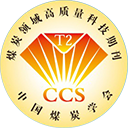



 下载:
下载:
